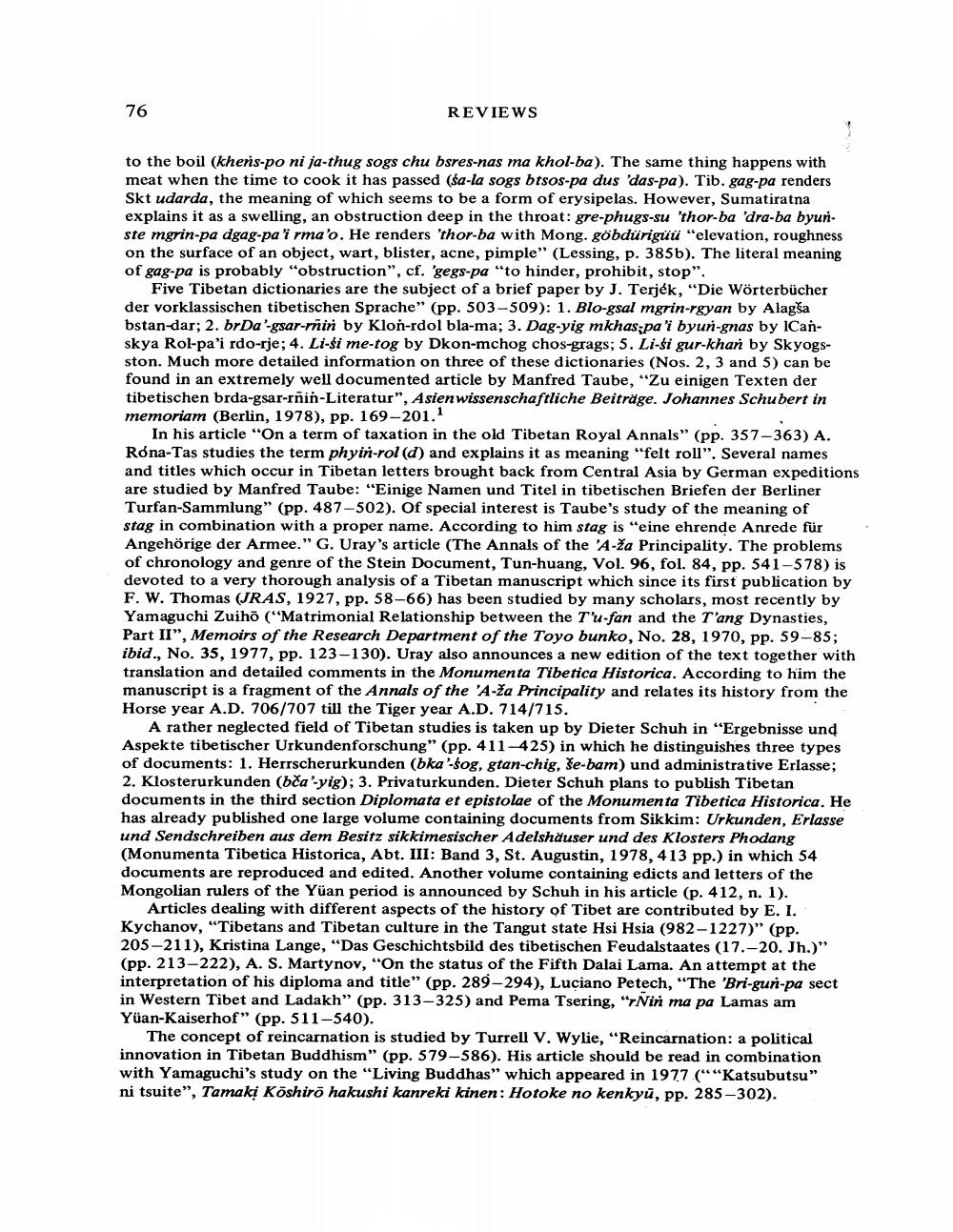Book Title: Book Reviews Author(s): J W De Jong Publisher: J W De Jong View full book textPage 6
________________ 76 REVIEWS to the boil (khers-po ni ja-thug sogs chu bsres-nas ma khol-ba). The same thing happens with meat when the time to cook it has passed (sa-la sogs btsos-pa dus 'das-pa). Tib. gag-pa renders Skt udarda, the meaning of which seems to be a form of erysipelas. However, Sumatiratna explains it as a swelling, an obstruction deep in the throat: gre-phugs-su 'thor-ba 'dra-ba byun. ste mgrin-pa dgag-pa i rma'o. He renders 'thor-ba with Mong. göbdüriguü "elevation, roughness on the surface of an object, wart, blister, acne, pimple" (Lessing, p. 385b). The literal meaning of gag-pa is probably "obstruction", cf. gegs-pa "to hinder, prohibit, stop". Five Tibetan dictionaries are the subject of a brief paper by J. Terjék, "Die Wörterbücher der vorklassischen tibetischen Sprache” (pp. 503-509): 1. Blo-gsal mgrin-rgyan by Alagša bstan-dar; 2. brDa'-gsar-rnir by Klon-rdol bla-ma; 3. Dag-yig mkhas pa'i byur-gnas by Canskya Rol-pa'i rdo-rje; 4. Li-si me-tog by Dkon-mchog chos-grags; 5. Li-si gur-khan by Skyogsston. Much more detailed information on three of these dictionaries (Nos. 2, 3 and 5) can be found in an extremely well documented article by Manfred Taube, “Zu einigen Texten der tibetischen brda-gsar-rñin-Literatur", Asien wissenschaftliche Beiträge. Johannes Schubert in memoriam (Berlin, 1978), pp. 169-201. In his article "On a term of taxation in the old Tibetan Royal Annals" (pp. 357-363) A. Róna-Tas studies the term phyin-rol (d) and explains it as meaning "felt roll". Several names and titles which occur in Tibetan letters brought back from Central Asia by German expeditions are studied by Manfred Taube: "Einige Namen und Titel in tibetischen Briefen der Berliner Turfan-Sammlung" (pp. 487-502). Of special interest is Taube's study of the meaning of stag in combination with a proper name. According to him stag is "eine ehrende Anrede für Angehörige der Armee." G. Uray's article (The Annals of the 'A-ža Principality. The problems of chronology and genre of the Stein Document, Tun-huang, Vol. 96, fol. 84, pp. 541-578) is devoted to a very thorough analysis of a Tibetan manuscript which since its first publication by F. W. Thomas (JRAS, 1927, pp. 58-66) has been studied by many scholars, most recently by Yamaguchi Zuiho ("Matrimonial Relationship between the T'u-fan and the T'ang Dynasties, Part II", Memoirs of the Research Department of the Toyo bunko, No. 28, 1970, pp. 59-85; ibid., No. 35, 1977, pp. 123-130). Uray also announces a new edition of the text together with translation and detailed comments in the Monumenta Tibetica Historica. According to him the manuscript is a fragment of the Annals of the 'A-ža Principality and relates its history from the Horse year A.D. 706/707 till the Tiger year A.D. 714/715. A rather neglected field of Tibetan studies is taken up by Dieter Schuh in "Ergebnisse und Aspekte tibetischer Urkundenforschung" (pp. 411-425) in which he distinguishes three types of documents: 1. Herrscherurkunden (bka'-sog, gtan-chig, še-bam) und administrative Erlasse; 2. Klosterurkunden (bča' yig); 3. Privaturkunden. Dieter Schuh plans to publish Tibetan documents in the third section Diplomata et epistolae of the Monumenta Tibetica Historica. He has already published one large volume containing documents from Sikkim: Urkunden, Erlasse und Sendschreiben aus dem Besitz sikkimesischer Adelshäuser und des Klosters Phodang (Monumenta Tibetica Historica, Abt. III: Band 3, St. Augustin, 1978, 413 pp.) in which 54 documents are reproduced and edited. Another volume containing edicts and letters of the Mongolian rulers of the Yüan period is announced by Schuh in his article (p. 412, n. 1). Articles dealing with different aspects of the history of Tibet are contributed by E. I. Kychanov, “Tibetans and Tibetan culture in the Tangut state Hsi Hsia (982-1227)" (pp. 205-211), Kristina Lange, "Das Geschichtsbild des tibetischen Feudalstaates (17.-20. Jh.)" (pp. 213-222), A. S. Martynov, "On the status of the Fifth Dalai Lama. An attempt at the interpretation of his diploma and title" (pp. 289-294), Luciano Petech, "The 'Bri-gun-pa sect in Western Tibet and Ladakh" (pp. 313-325) and Pema Tsering, "Nin ma pa Lamas am Yüan-Kaiserhof” (pp. 511-540). The concept of reincarnation is studied by Turrell V. Wylie, “Reincarnation: a political innovation in Tibetan Buddhism" (pp. 579-586). His article should be read in combination with Yamaguchi's study on the "Living Buddhas" which appeared in 1977 (""Katsubutsu" ni tsuite", Tamaki Koshiro hakushi kanreki kinen: Hotoke no kenkyū, pp. 285-302).Page Navigation
1 ... 4 5 6 7 8 9 10 11 12 13 14 15 16 17 18 19 20 21 22 23 24 25 26 27 28 29 30 31 32 33 34 35 36 37 38
